The aircraft carrier that never was
- Published
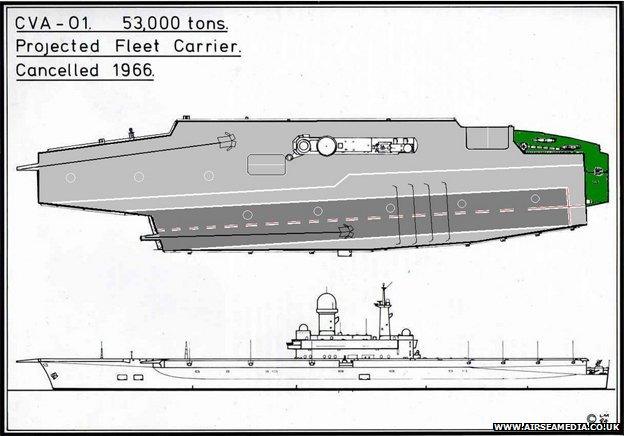
The Queen is about to name the first of the UK's controversial new-generation aircraft carriers in a ceremony at Rosyth. But a plan for a super-carrier five decades ago ended in acrimony.
HMS Queen Elizabeth is a major milestone for the Royal Navy and for British defence.
It also provides a strong echo with the past, and the Royal Navy's last - failed - bid for a new-generation of full-size aircraft carriers half a century ago. The first of those ships was designated CVA-01. Like the new ship, she would have been called HMS Queen Elizabeth. But she was the carrier that never was.
Pretty much all that remains of her - apart from a few architect drawings and artist impressions - is a model in a storeroom at the Fleet Air Arm museum at Yeovilton. But her saga has huge resonance for today.
Like the new HMS Queen Elizabeth, she would have been the largest warship ever built for the Royal Navy. About the same size, at 55,000 tons compared with 65,000 tons for today's ship, 963ft long compared with 930ft, and capable of carrying about 40 aircraft.
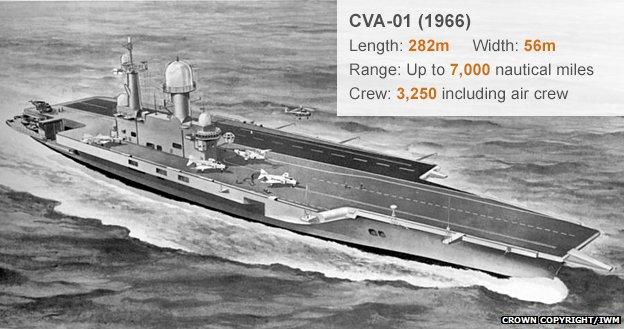

Meant to replace the navy's then ageing carrier fleet, she would have been a radical new design for her day, with a new 3D radar, a novel flight deck arrangement, and other innovations. Like the new carriers, she was also hugely controversial and the subject of bitter inter-service rivalry, with arguments over whether she was too large and too ambitious.
But, unlike the new ships, she was cancelled in 1966 before an order was ever placed.
The then Labour government was facing economic pressure and a sterling crisis, and looking to cut defence spending as Britain's post-Imperial world role diminished. It was decided that the navy's carriers had to go.
For the navy of the time this was a huge trauma, removing the main pillar on which its post-World War Two fighting power was based. It meant painful readjustment and a change of course to a more limited role focused on Nato rather than lingering commitments east of the Suez canal. The then head of the navy, and the navy minister resigned over the decision.
In the end, the navy did get some new mini-carriers, of just 20,000 tons, like HMS Invincible, which played a vital role in the Falklands War. They could operate only the small Sea Harrier jump jet, also of Falklands fame. But the combination still gave the navy the vestige of a global capability that made fighting the Falklands War possible.

Aircraft carriers key conflicts:
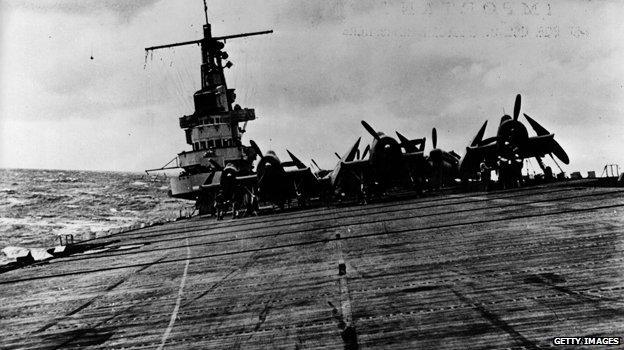
Aircraft from carrier HMS Illustrious cripple Italian fleet in a daring night attack on Taranto (1940)
Japan attacks US warships at the Pearl Harbour, but crucially fails to tackle its aircraft carriers, which are not in harbour at the time (1941)
Pacific battles of Coral Sea and Midway fought between opposing fleets of aircraft carriers, resulting in victory for US forces against Japan (1942)
US, British and Australian carriers play a crucial role in supporting United Nations forces during the Korean War (1950-53)
Royal Navy carriers support British forces sent to support Kuwait against threatened Iraqi attack (1961)
Britain's defence of the Falklands made possible by aircraft carriers (1982)
Leo Marriott, naval and aviation author

To this day, the battle over CVA-01 still scars many who served in the navy. And many navy veterans still believe the RAF cheated in making its arguments in the 1960s that its land-based aircraft could do the job of the carriers, by producing maps that showed Singapore 400 miles closer to Australia than it really is.
I interviewed the last chief designer of CVA-01, Louis Rydill, just before he died, and he confirmed that he had said that the day the project was cancelled was the happiest of his life. However, that was not because he did not believe in the carrier case. It was because he felt that he had been forced to make so many compromises, and introduce so many risky design elements, because of size and budget restrictions, that the whole project had become a nightmare.
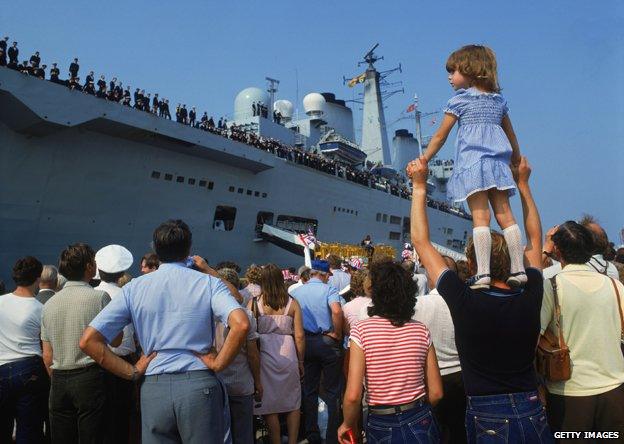
HMS Invincible at Portsmouth, carrying British troops home from the Falklands War, September 1982
All this underlines the fact that the new Queen Elizabeth (and her planned sister ship HMS Prince of Wales) is really an heir to her doomed namesake and the navy's big carriers of old, rather than the most recent generation of smaller carriers like HMS Invincible.
In fact, the navy's new carriers are three times bigger than their immediate predecessors. And they will provide a scale of carrier capability that the navy and the country have not had for nearly 40 years (since the retirement of the previous generation including HMS Ark Royal of TV Sailor fame).
That was a deliberate decision of the 1998 Strategic Defence Review, which gave the project the green light. It was following the end of the Cold War and the return to a more globalised outlook.
But attempting to revive that level of "power projection" has been part of the controversy that has swirled around the ships for so long. There have also been the many delays in the project, the arguments over what type of aircraft they should operate, and the fact that the total cost for the two ships is now estimated at more than £6bn (and that is before adding the cost of their aircraft).
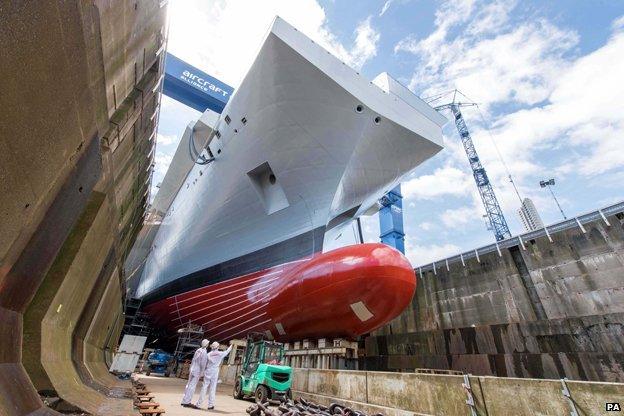
For their supporters, they will be hugely valuable strategic assets for the country, and major platforms from which all the services will be able to operate in a wide variety of roles. They will, so the argument goes, give governments options for intervention or exerting influence that they have not had for more than a generation, in a world in which there will be an understandable reluctance to commit "boots on the ground" for the foreseeable future.
It will also be in a world in which new emerging powers are trying to get into the carrier business as well. And the new ships are supposed to last for 50 years.
But all that, some critics argue, is part of the problem, and the idea that the country is still trying to be a global player on the scale that these new ships imply. Other critics continue to question their usefulness and cost in a world in which cyber and other threats should be more of a priority.
Today's admirals are understandably sensitive about looking too much into the past, and see the new carriers very much as ships for the future. But, for many old Navy hands, the arrival of the new HMS Queen Elizabeth on the scene will go some way to righting what they see as a historical wrong from the 1960s.

The Magazine on aircraft carriers
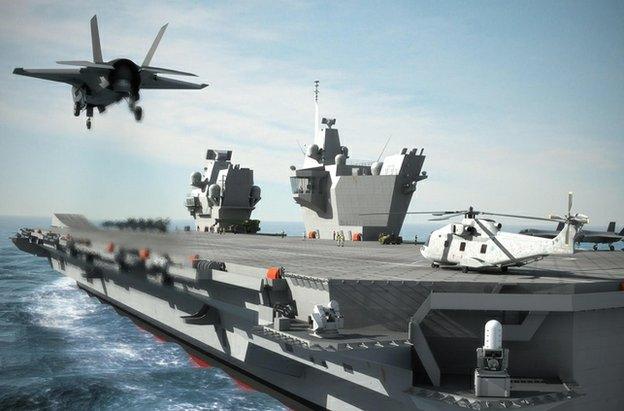
A major piece of Britain's new one has arrived at a dockyard, China is testing one, but 100 years after the concept was invented, does anybody still need aircraft carriers, asks Tom de Castella.
In a shipyard in Scotland the future of the Royal Navy is slowly taking shape. But the construction of the aircraft carrier HMS Queen Elizabeth is a mammoth task, says Chris Summers.

Subscribe to the BBC News Magazine's email newsletter to get articles sent to your inbox.